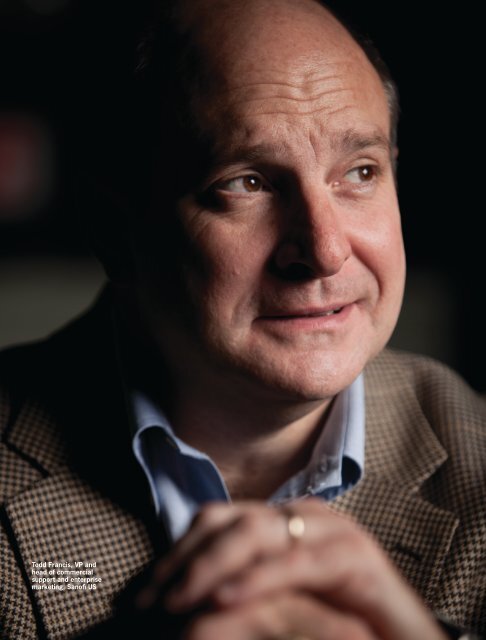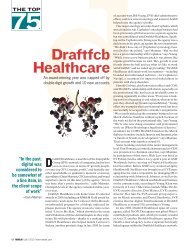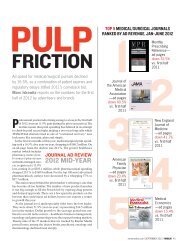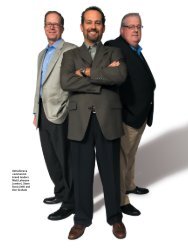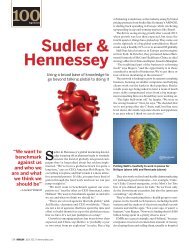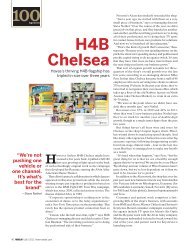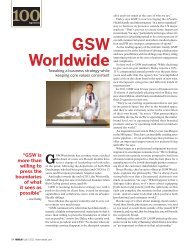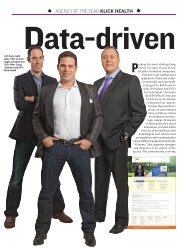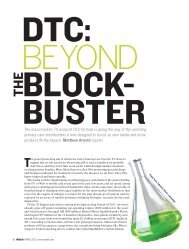Analyze this - Medical Marketing and Media
Analyze this - Medical Marketing and Media
Analyze this - Medical Marketing and Media
You also want an ePaper? Increase the reach of your titles
YUMPU automatically turns print PDFs into web optimized ePapers that Google loves.
Todd Francis, VP <strong>and</strong><br />
head of commercial<br />
support <strong>and</strong> enterprise<br />
marketing, Sanofi US<br />
34 MM&M x MARCH 2012 x mmm-online.com
PHOTO LEFT: J CARRIER<br />
STATE OF MARKET RESEARCH<br />
ANALYZE<br />
THIS<br />
To whom do br<strong>and</strong>s turn for help when they are calibrating their<br />
marketing mix for a coming launch? And, as some sales forces<br />
shift focus toward customer satisfaction instead of traditional<br />
sales quotas, how are commercial teams sizing up rep compensation?<br />
Last question: Who are drugmakers increasingly counting on<br />
to provide messaging to convince skeptical payers of a product’s<br />
value proposition?<br />
The above are just some of the many requests folks in market<br />
research are getting these days. Yet, after a spate of layoffs, fewer<br />
of them are around to field those questions. And according to the<br />
most recent State of the Industry (SOI) survey, a declining number<br />
of market researchers expects to have a big influence on commercial<br />
decision making. Agreement on that score went from high in 2010<br />
to lukewarm in 2011.<br />
These trends—downsizing <strong>and</strong> the perception of waning influence,<br />
along with agreement that the pace of consolidation will rise—should<br />
serve as a wake-up call for a field that’s used to showing value for<br />
a decision but not necessarily touting its own worth.<br />
“I don’t think anyone could argue the point that there’s a strong<br />
desire <strong>and</strong> obligation to improve how we package <strong>and</strong> deliver the<br />
insights that are generated from our analysis,” says Todd Francis,<br />
VP <strong>and</strong> head of commercial support <strong>and</strong> enterprise marketing for<br />
Sanofi US.<br />
Analytical weak points in most urgent need of improvement are<br />
spotlighted by the SOI survey, along with a host of pharma marketing<br />
research trends like where research spend is pegged to increase. But<br />
the downsizing trend looms larger, for obvious reasons.<br />
Market research must<br />
transform itself or run<br />
the risk of becoming<br />
obsolete. Marc Iskowitz<br />
teams with the PMRG<br />
<strong>and</strong> TGaS Advisors to<br />
review the cold hard facts<br />
Down in the count<br />
One soft indicator of the attrition rate is that in 2011 vs. 2010, 27%<br />
fewer manufacturers (137) responded to the SOI survey, which is<br />
developed in collaboration with TGaS Advisors <strong>and</strong> an advisory<br />
committee of the Pharmaceutical <strong>Marketing</strong> Research Group representing<br />
all PMRG constituencies (drug <strong>and</strong> device makers, as well<br />
as suppliers/consultants). Curiously, over that period the number of<br />
suppliers/consultants responding (169) rose by the same rate.<br />
The reasons behind the downsizing are well known to anyone<br />
who follows the pharma industry. Br<strong>and</strong>s are maturing <strong>and</strong> thus<br />
requiring less overall analytical support.<br />
“New products are the ones that need the most information (primary<br />
<strong>and</strong> secondary research, ROI analysis, payer assessments, etc.),”<br />
explains T.J. Scott, director of marketing sciences, management<br />
advisor, for TGaS. Since the industry as a whole is supporting fewer<br />
br<strong>and</strong>s, it’s reducing headcount per br<strong>and</strong> while boosting spend-perperson,<br />
a surrogate for effort. (Short of an accurate gauge on these<br />
industry stats, Figs. 1-2 are based on TGaS client data.)<br />
With manufacturer-based marketing researchers going through<br />
similar trials <strong>and</strong> tribulations as their counterparts in sales <strong>and</strong> clinical<br />
research, research departments are spread thin, belying their<br />
importance. That has implications for those in the trenches.<br />
According to Francis, who oversees the marketing research function<br />
for Sanofi US, “Some of the work that’s been done of late moves<br />
toward transactional activity. You’re spending more time waiting for<br />
the questions to be asked.”<br />
He describes <strong>this</strong> focus on technical analysis as a “self-fulfilling<br />
mmm-online.com x MARCH 2012 x MM&M 31
ANALYZE THIS<br />
Fig.1: Headcount (per br<strong>and</strong>) for marketing<br />
sciences is falling<br />
7.0<br />
6.0<br />
5.0<br />
4.0<br />
3.0<br />
2.0<br />
1.0<br />
0<br />
2.6<br />
6.2<br />
1.4<br />
2.7<br />
1.1<br />
3.0<br />
2006 2007 2008 2009 2010 2011<br />
Primary MR FTEs per br<strong>and</strong><br />
Note: Includes data from 51 manufacturer marketing science operations (MSOP) engagements<br />
Source: TGaS Advisors, MSOPs Database 2006-2011<br />
prophecy,” an outgrowth of the cost-cutting environment researchers<br />
find themselves in: “With reduced [research] headcount, [<strong>and</strong>] the<br />
same number of marketers asking the same amount of questions,<br />
you become less able to think about what you need to be doing next<br />
<strong>and</strong> more focused on the questions that are being asked.”<br />
If they’re not careful, market researchers can become stuck in <strong>this</strong><br />
transactional mode, warns Praveen Advani, director/team leader,<br />
global market research & analytics at Merck. “We have traditionally<br />
seen ourselves as an expert in executing projects <strong>and</strong> providing<br />
recommendations,” Advani tells MM&M. “Frankly, <strong>this</strong> is how we<br />
have been rewarded by our employers. The world is changing.”<br />
And market researchers, Advani says, need to change with it,<br />
adjusting for the new reality of slower product approvals, blockbusters<br />
going off patent <strong>and</strong> generics increasing their presence. “If we don’t<br />
evolve, Market Research could be outsourced <strong>and</strong> the function as<br />
we know it today could soon be obsolete.”<br />
Analytical weak points<br />
So, what are the areas most in need of improvement? Respondents to<br />
the SOI survey spotlight the biggest analytical weak points as being<br />
payer <strong>and</strong> ex-US secondary techniques (see Fig. 7). Notably, these<br />
are also among the areas where they see research spend increasing<br />
the most, in addition to larger outlays for qualitative <strong>and</strong> quantitative<br />
<strong>and</strong> for social media for research.<br />
With managed care <strong>and</strong> government influence holding sway over<br />
therapy choice (Fig. 5), it’s no surprise that respondents are hungry<br />
for better payer analysis. But respondents to the SOI survey, fielded<br />
in November 2011, agreed strongly (8.1) that payer research needs<br />
to improve.<br />
Why is <strong>this</strong> research lacking? Surely, the great fluidity in the payer<br />
market has not helped drug <strong>and</strong> device makers get a h<strong>and</strong>le on it. And<br />
in the past several years, managed markets has become a separate arm<br />
of marketing so, internally a least, manufacturers may still be trying<br />
to figure out a cohesive strategy for incorporating the payer.<br />
There also continues to be very strong agreement that the focus<br />
on global emerging markets will continue. Is an adequate analytical<br />
infrastructure in place overseas to support the added attention? No,<br />
says Merck’s Advani, <strong>and</strong> <strong>this</strong> is a barrier to successful launches,<br />
32 MM&M x MARCH 2012 x mmm-online.com<br />
0.7<br />
2.1<br />
1.1<br />
2.9<br />
0.8<br />
MSOPS FTEs per br<strong>and</strong><br />
1.9<br />
Fig.2: Manufacturers’ research work load has<br />
increased<br />
$1600<br />
Pharma RFPs are very clear<br />
$1200<br />
$800<br />
$849<br />
$930<br />
$400<br />
Pharma underst<strong>and</strong>s use of techniques<br />
0<br />
Note: Primary research spend managed per FTE ($000s)<br />
Source: TGaS Advisors<br />
$1,358<br />
$1,402 $1,397<br />
$1,535<br />
2006 2007 2008 2009 2010 2011<br />
especially for pre-launch products as the focus locally continues to<br />
be on maximizing in-line br<strong>and</strong>s.<br />
Pharma is slowly learning more about the needs of customers<br />
in the BRIC countries in an effort to build a value proposition for<br />
products, but it’s still playing catch-up. “We seem to react <strong>and</strong> not be<br />
as proactive as we should be,” Advani laments. “We have to get ahead<br />
of the curve <strong>and</strong> leverage learnings from other mature markets.”<br />
Another one of the top trends flagged by respondents to the SOI<br />
survey was the strong agreement among manufacturers <strong>and</strong> suppliers/consultants<br />
that secondary data still need to evolve. When<br />
asked to rate, on a 1-10 scale, how many agree that these sources<br />
are satisfactory, total respondents scored US secondary data a 5.5.<br />
Outside the US, the score plummets to a mediocre 3.8.<br />
Notably, medical device secondary data scored much lower than<br />
pharma secondary data. Says TGaS’s Scott, “Pretty much all data<br />
is [subst<strong>and</strong>ard] for them [<strong>and</strong> not just in developing countries]….<br />
It’s an opportunity for somebody to look at that <strong>and</strong> see if they can<br />
build better data sources.”<br />
Device firms want richer insight now, says Michele Fuller, global<br />
head of marketing sciences for Novartis’ Alcon unit. While advancements<br />
in EMRs <strong>and</strong> other technology could bring faster, better data<br />
quality to healthcare providers <strong>and</strong> industry, progress is slow. “Our<br />
ability to perform these analytics is vastly limited, <strong>and</strong> we are in desperate<br />
need of innovation from our suppliers,” she tells MM&M.<br />
But even the bigger suppliers are struggling to exp<strong>and</strong> knowledge<br />
in the emerging markets. Nielsen has offices in 100 countries <strong>and</strong><br />
over the past two years the research giant has seen significantly<br />
increased dem<strong>and</strong> to do primary <strong>and</strong> secondary research in China,<br />
Brazil <strong>and</strong> Russia.<br />
Outside of his own firm’s sizable network, Milos Graonic, SVP,<br />
global pharmaceutical practice leader for Nielsen, says third-party<br />
suppliers willing to collect data <strong>and</strong> find information in these territories<br />
are becoming more commonplace, <strong>and</strong> that’s made it easier to<br />
refine research quality. But while data collection has changed for the<br />
better in these markets, the status of secondary data has not. “Most<br />
often it’s not available <strong>and</strong> when it is, it’s often not reliable.”<br />
As far as primary research goes, researchers need to do “completely<br />
different reads” in the BRIC countries when talking to
Fig.3: Gaps between vendors <strong>and</strong> clients are<br />
growing wider…<br />
Vendors deliver high quality proposals<br />
Pharma RFPs are very clear<br />
Vendors underst<strong>and</strong> our business objectives<br />
Pharma business objectives are clear<br />
Vendors propose appropriate techniques<br />
Pharma underst<strong>and</strong>s use of techniques<br />
3.9 (vs. 4.7)<br />
4.4 (vs. 4.7)<br />
4.2 (vs. 4.5)<br />
6.0 (vs. 6.6 in 2010)<br />
6.0 (vs. 6.5)<br />
6.2 (vs. 6.8)<br />
0 1 2 3 4 5 6 7 8<br />
level of agreement<br />
Pharma company Vendor<br />
Note: Mean scores; respondents were asked to rate level of agreement on 10-point scale (10, totally agree; 1, totally disagree)<br />
Source: PMRG State of the Industry Survey, 2012<br />
patient, payer <strong>and</strong> healthcare provider. Yet, “very few [clients] are<br />
one hundred percent committed to do country-based research in<br />
depth,” Graonic says.<br />
P<strong>and</strong>ora’s box<br />
Graonic also foresees possible government restrictions on secondary<br />
data in Brazil <strong>and</strong> China, as they exist in Europe. “It’s difficult<br />
to predict to what degree [the data roadblocks] will exist,” he says.<br />
For instance, what information the Chinese government allows<br />
researchers to collect “is a pure P<strong>and</strong>ora’s box.”<br />
The uncertainty abroad st<strong>and</strong>s in contrast to the seemingly less<br />
risky situation here in the States, at least among SOI survey respondents,<br />
fewer of whom agreed that there will be new restrictions on<br />
the sources <strong>and</strong> uses of secondary data. The US Supreme Court’s<br />
ruling last year in favor of pharma <strong>and</strong> data companies in Sorrell<br />
vs. IMS Health no doubt soothed some concerns.<br />
Yet there are reasons to remain vigilant on the policy front. Especially<br />
with the Sunshine Act set to go into effect soon, <strong>and</strong> as large<br />
practices forbid their members to participate in marketing research,<br />
reluctance to join healthcare provider panels could increase. If the<br />
pool of physicians participating were to fall because of the law,<br />
“You’re going to put more research against a smaller subset of<br />
physicians, <strong>and</strong> your quality of data will ultimately suffer,” warns<br />
Glen Bergstein, co-founder of BluePrint Research Group.<br />
Biopharma respondents agreed on where they don’t see spend<br />
increasing—drug promotion—but concur that the evolution of promotion<br />
will continue (Fig. 6). This can have effects for measurement.<br />
GlaxoSmithKline pioneered a sales model where reps aren’t compensated<br />
for prescriptions that physicians write or hitting a sales goal, but<br />
on customer interaction <strong>and</strong> satisfaction ratings. Who tracks that?<br />
“Part of what the market research function does is help with [sales<br />
force] compensation,” says Judy Stewart, a VP at GSK who sits in<br />
the drugmaker’s cardiovascular marketing group <strong>and</strong> interfaces<br />
heavily with market research. “So they’ve had to get very creative<br />
with [measuring] customer satisfaction…at the physician level.”<br />
GSK’s focus seems to make sense. After all, in most consumer markets,<br />
satisfaction <strong>and</strong> loyalty drive business. But there was mild accord<br />
among pharma-based respondents (6.0) that there will be a focus on<br />
uerosTo commoDo oDionul<br />
Fig.4: …<strong>and</strong> both are less satisfied with the<br />
relationship than last year<br />
Vendors respond to questions in a timely manner<br />
Pharmas resond to questions in a timely manner<br />
Vendors deliver high quality results<br />
Pharmas deliver results to clients’ expectations<br />
Vendors’ cost is appropriate for the value delivered<br />
Pharma’s price is adequate to perform research<br />
0 1 2 3 4 5 6 7 8<br />
Note: Mean scores<br />
Source: PMRG State of the Industry Survey, 2012<br />
level of agreement<br />
4.7 (vs. 5.2)<br />
Pharma company Vendor<br />
6.8 (vs. 7.5 in 2011)<br />
6.4 (vs. 7.0)<br />
5.9 (vs. 6.4)<br />
6.0 (vs. 6.9)<br />
7.1 (vs. 7.0)<br />
these techniques to drive sales <strong>and</strong> moderate agreement (6.8) in the<br />
need for better techniques for getting at customer satisfaction.<br />
“That was no small task” says Stewart of determining rep compensation<br />
based on customer happiness. In GSK’s case, the firm gauges<br />
satisfaction via a mix of primary research along with what Stewart<br />
calls “st<strong>and</strong>ard reports” of prescriber attitudes <strong>and</strong> behavior.<br />
Other relatively new metrics which researchers are helping generate<br />
insights for include specialty pharmacy data, consumer sentiment<br />
<strong>and</strong> outcomes. With regard to the latter, Stewart says, “Being able<br />
to see long-term outcomes is key for us to be able to build a costbenefit<br />
story for payers. There’s still a gap there.”<br />
And researchers are still trying to wrap their tape measures around<br />
the explosion of data generated from digital media, data which is<br />
often unstructured <strong>and</strong> does not allow for clean analysis.<br />
Integrated campaigns using print, TV <strong>and</strong> digital will require unique<br />
skills to assess, so Sanofi US has started an Analytics University to<br />
improve such researcher skills as the package <strong>and</strong> delivery of insights<br />
<strong>and</strong> technique. “We can always sharpen the saw,” Francis says.<br />
As did respondents to the SOI survey, Francis predicts that TV<br />
<strong>and</strong> print media spend will stay relatively flat but that research<br />
teams will continue to have to evaluate br<strong>and</strong>ed <strong>and</strong> non-br<strong>and</strong>ed<br />
print <strong>and</strong> TV ads (for impact, customer experience, etc.) <strong>and</strong> then<br />
take the next step—providing counsel to the marketing teams on<br />
how to allocate spend for the integrated campaign.<br />
Vendor-client relations<br />
Turning to Figures 3-4, the SOI survey reveals another gap, <strong>this</strong> time<br />
a widening chasm in the relationships between suppliers <strong>and</strong> clients.<br />
For instance, suppliers <strong>and</strong> consultants, when asked about the clarity<br />
of RFPs they receive, assigned RFPs a relatively low rating (3.9 vs.<br />
4.7 in 2010), <strong>and</strong> they felt they could do a better job if they had more<br />
access to internal stakeholders. Manufacturers also downgraded<br />
their rating of vendor proposals, to 6.0 vs. 6.6.<br />
Bergstein thinks <strong>this</strong> disconnect is due to margins getting tighter.<br />
“If I were a big [research] company, staffing a lot of people, <strong>and</strong> my<br />
margin got squeezed…more junior people are going to be h<strong>and</strong>ling<br />
the work, <strong>and</strong> that’s going to challenge the quality.”<br />
Another reason could be the proliferation of preferred ven-<br />
mmm-online.com x MARCH 2012 x MM&M 33
ANALYZE THIS<br />
Fig.5: Influences on therapy choice will continue<br />
to increase<br />
10.0<br />
8.0<br />
6.0<br />
4.0<br />
2.0<br />
0<br />
8.7<br />
Note: Mean scores biopharma respondents<br />
Source: PMRG State of the Industry Survey, 2012<br />
Fig.6: The evolution of product promotion is<br />
far from over<br />
Sales force sizes will decline<br />
Decreased access to key decision makers<br />
Digital marketing to patients will increase<br />
Digital marketing to HCPs will increase<br />
Greater focus on compliance with regs<br />
Note: Mean scores biopharma respondents<br />
Source: PMRG State of the Industry Survey, 2012<br />
5.2<br />
34 MM&M x MARCH 2012 x mmm-online.com<br />
7.0 (vs. N/A)<br />
7.9 (vs. 8.4 in 2011)<br />
8.1 (vs. 8.5)<br />
8.2 (vs. 8.7)<br />
8.5 (vs. 8.3)<br />
0 2 4 6 8 10<br />
level of agreement<br />
Fig.7: Shifts in research spending are in store,<br />
<strong>and</strong> secondary data sources still need to evolve<br />
Spending on global will increase<br />
Note: Mean scores all respondents<br />
Source: PMRG State of the Industry Survey, 2012<br />
8.6<br />
Managed care/payers Federal/state government<br />
5.2<br />
Spending on secondary specialty/payer data will increase<br />
Current secondary data sources are sufficient (US)<br />
Current secondary data sources are<br />
sufficient (ex-US)<br />
2010<br />
There is a need for better payer research<br />
3.8 (vs. N/A)<br />
2011<br />
8.4<br />
5.5 (vs. 5.0)<br />
7.6 (vs.<br />
7.7 in<br />
2011)<br />
7.2 (vs.<br />
N/A)<br />
8.1 (vs.<br />
N/A)<br />
0 1 2 3 4 5 6 7 8<br />
level of agreement<br />
8.1<br />
dor relationships. According to Advani, “In that scenario, market<br />
researchers may have a comfort level with vendors they currently<br />
work with <strong>and</strong> will provide the minimal amount of information<br />
needed to pull together a proposal.”<br />
But he doesn’t see the situation negatively impacting research<br />
efforts at Merck, which is moving toward a partnership model with<br />
vendors that will aim for speed, simplicity <strong>and</strong> savings while preserving<br />
quality deliverables. For <strong>this</strong> to happen, he says, “we need to<br />
communicate more with our vendors—not only about the scope of<br />
the research project, but the br<strong>and</strong> strategy, prior research findings<br />
<strong>and</strong> secondary market data.”<br />
Adds GSK’s Stewart, “Oftentimes, we don’t really connect in with<br />
the marketing research companies or consultants we’re using until<br />
the end. There could be a tighter relationship in the upfront piece<br />
to set the objectives.”<br />
More urgent than these issues for research as a profession, however,<br />
may be the leadership vacuum. “Market research, in general,<br />
needs to decide what strategic advantage they want to provide to<br />
the organization,” says Francis. “We need to begin to differentiate<br />
strategic responsibility from tactical research.”<br />
Sanofi US has begun to do just that through making tradeoff<br />
decisions on where researchers spend their time. Not surprisingly,<br />
Francis favors forward-thinking work: product-launch preparation,<br />
competitive-launch l<strong>and</strong>scaping, marketing-mix assessment <strong>and</strong><br />
predictive modeling. These tasks require advanced technical skills<br />
<strong>and</strong> an ability to communicate the findings to a very broad audience.<br />
The more tactical, operational activities are left to other parties,<br />
whether that be a third party or a full outsource.<br />
Doing so “will help the marketing research function distinguish<br />
itself in the greater pharma value chain,” Francis says.<br />
Adds Merck’s Advani: When researchers partner with br<strong>and</strong><br />
teams <strong>and</strong> provide insights beyond what is learned, rewarding relationships<br />
<strong>and</strong> big business impact follow. “We need to transform to<br />
being strategic business owners <strong>and</strong> realize that it’s not just about<br />
the data, it’s what we do with that data,” he urges.<br />
It also wouldn’t hurt for manufacturer-based marketing researchers<br />
to develop a business case for their groups. Most MR groups “aren’t<br />
building analytics to show how valuable they are,” explains TGaS’s<br />
Scott. “They’re helping show value for a decision, but they don’t add<br />
it up <strong>and</strong> say, ‘We’re really valuable; <strong>this</strong> is why you need us.’”<br />
‘own your information’<br />
BluePrint’s Bergstein, who spent several years at Bristol-Myers<br />
Squibb before opening his consultancy, offers manufacturer-based<br />
researchers one salient piece of advice picked up from his BMS days:<br />
“own your own information.” Present data yourself, as he who presents<br />
the data exerts the greatest impact on the commercial team.<br />
“Your agency is a very important piece of the puzzle to help<br />
empower you <strong>and</strong> to work as a partner with you to develop those<br />
insights <strong>and</strong> recommendations,” he says. “But ultimately it’s up to<br />
you to deliver those to your teams.”<br />
While an atmosphere of cost-cutting <strong>and</strong> slimmer research budgets<br />
isn’t the best setting for a period of soul-searching, a change in mindset<br />
is in order for <strong>this</strong> profession to take ownership of its business.<br />
“Headcount is precious,” says Francis, so “everyone, whether you’re<br />
a researcher or not, needs to continue to show the value they bring to<br />
the organization. And those functions that don’t provide that value<br />
are the ones who are going to be scrutinized the greatest.” n


